Shows
Roundtable Review: Shirley Tse’s “Stakes and Holders”
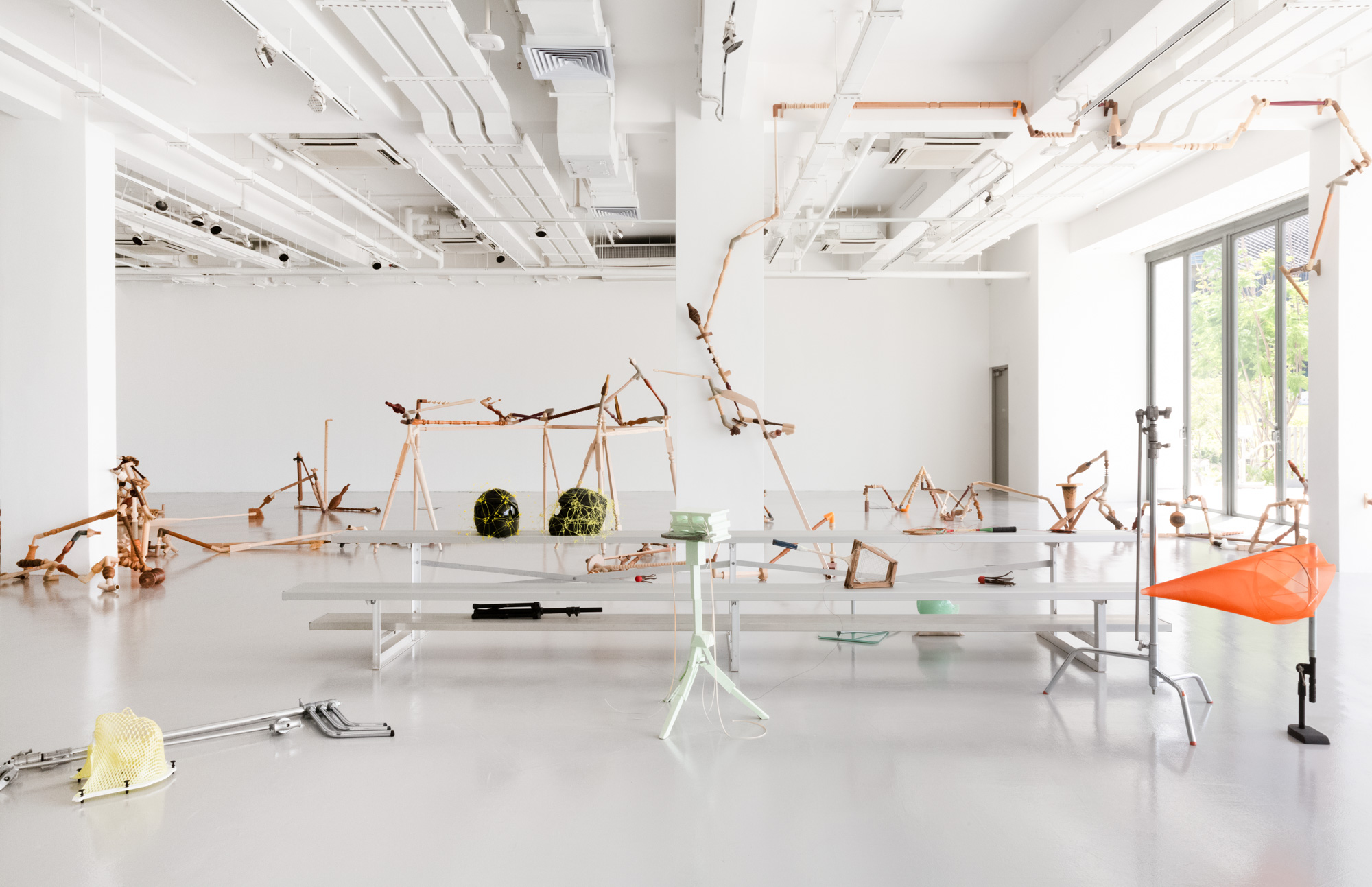

“Reveals integrity and hope”
Shirley Tse’s installation of conjoined, carved-wood pieces, Negotiated Differences (2019–20), includes an awkward cubic structure. Apparently, during a remote meeting between the Los Angeles-bound Tse and her onsite team at M+, someone suggested the configuration—so they tried it. This ethos of collaborative experimentation came to the fore in “Stakes and Holders,” which responded to our progressively fractured present with an imaginative proposition of pluralist connection.
Tse’s splitting of “stakeholders” in the title subverts the term’s original connotations of individualized actors, signalling the show’s focus not on singular but constituent parts. Composed of unpainted wooden sculptures of quotidian objects that slot together like pieces in a toy building set, Negotiated Differences points to the productive efforts of play, of an approach that works constructively, not conflictually, with mismatched components.
Likewise, Playcourt (2019–20) situates 19 standalone sculptures in a nonsensical game of badminton. Again, ordinary objects appear in unexpected likenesses and configurations, as in Tse’s shuttlecocks made of vanilla pods and rubber, commodities that nod to British colonial histories in the region. Yet Tse eschews political grandstanding, embedding issues of power within a wider study of life in Hong Kong. Tse’s variegated installations advocate for a plurality of sense, which entails an understanding that the world is constituted from multiple standpoints that need to be meaningfully articulated and negotiated. At a time when plurality is under attack by both repressive governments and echo-chamber-style discourse, Tse’s work reveals integrity and hope. OPHELIA LAI
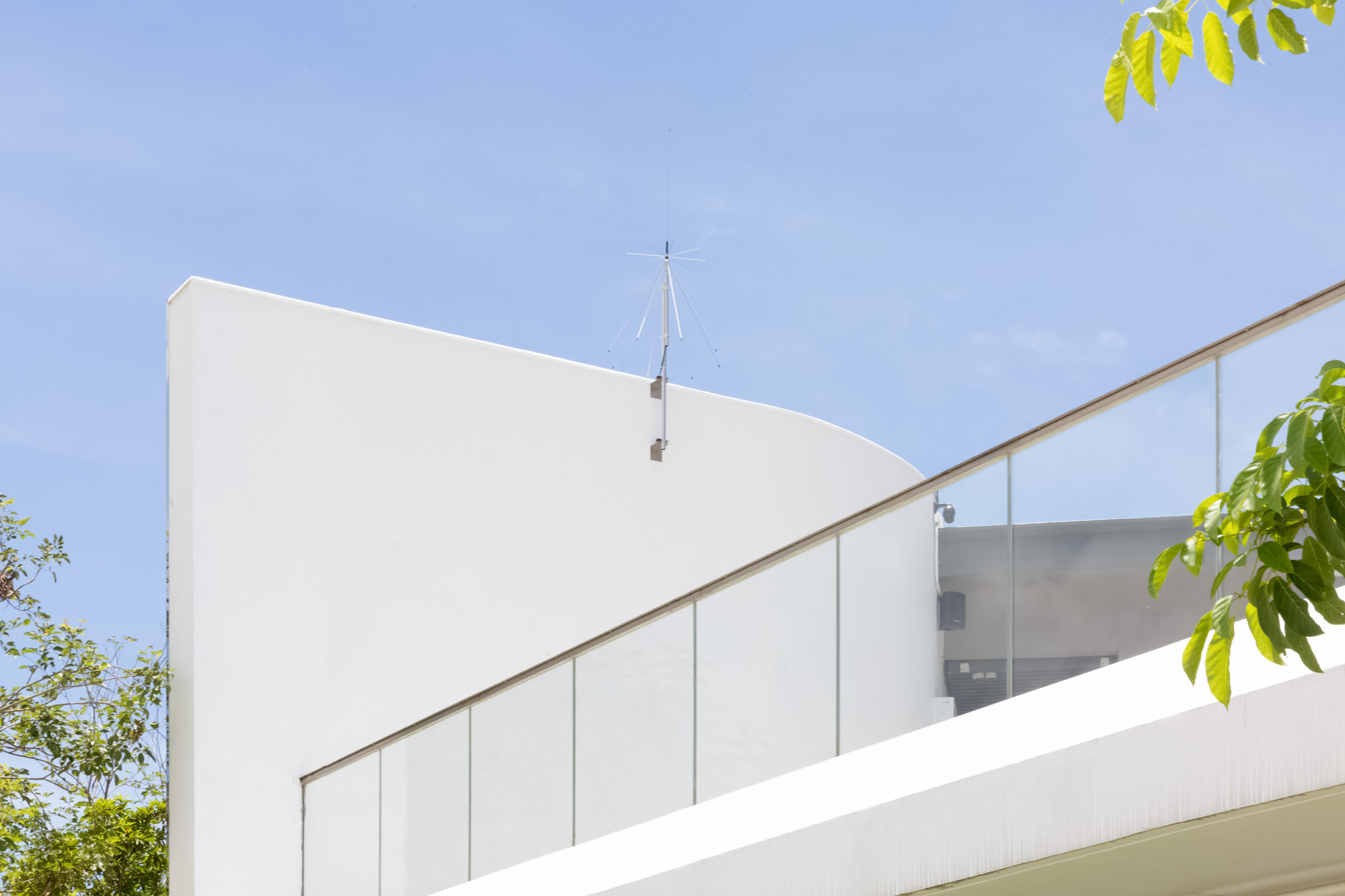
“Not hopeful”
A match on Shirley Tse’s badminton-inspired Playcourt (2019–20) installation could involve two, 30, or any number of players. They could choose to compete or cooperate with each other. They might keep score, or not. There are no apparent rules; there isn’t a singular narrative. Instead, the work’s wildly varied components—including metal bleachers, a vanilla-pod-studded shuttlecock, and other sculptures made of manufactured and organic items, each with a multitude of possible significances—suggest notions of multiplicity and improvised play as means for bucking hegemonic mechanisms. The thematic importance of cacophony and the interactions between disparate elements were amplified by the amateur radio channels broadcast on the pavilion’s terrace as a “[response] to the increasingly stringent control of the public domain,” in curator Christina Li’s words, as well as the show’s other installation, Negotiated Differences (2019–20), a sprawling network comprising turned wooden pieces of all shapes and sizes.
Yet, for all its emphasis on the radical potentials of finding interconnectivity within heterogeneity, “Stakes and Holders” is not hopeful. As the title of the latter work implies, the meeting of different forces requires negotiation. My experience at the exhibition reflected this. As I read the show guide about Tse’s ludic proposition for the reclamation of public spaces, an overzealous team of security guards and attendants pointedly monitored my every move, bringing to mind the authoritarian powers bearing down on dissentient behaviors. The show reminded me that we are all stakeholders, but some of us have a harder fight to the table than others. CHLOE CHU
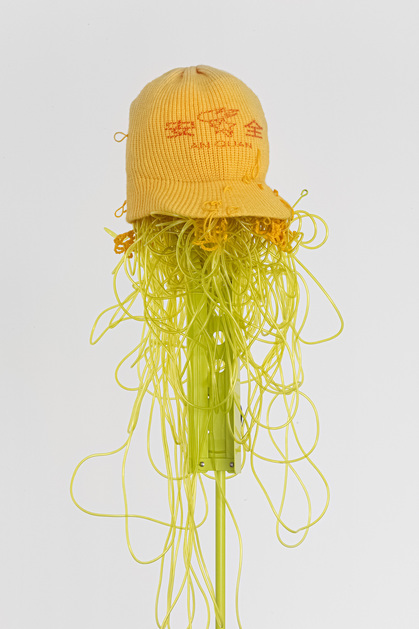
“The artist’s thoughtful materialization of her own identity”
“Shirley Tse: Stakes and Holders” referenced the artist’s childhood in Hong Kong while simultaneously drawing upon the city’s colonial past. Negotiated Differences (2019-20), a sequence of connected 3D-printed wooden pieces, sprawls on the ground, extending onto the columns of the exhibition space. Looking closely, I recognized miscellaneous everyday objects, and was fascinated with the heterogeneity of Tse’s materials—toy-like wooden blocks converged with bowling pins, held together with molds shaped like pipe systems and umbrella handles, the latter a nod to Hong Kong’s 2014 pro-democracy social movement.
While Negotiated Differences evokes familiarity with its interlinking of mismatched forms, the tangibility of memory is also explored in Playcourt (2019-20), an installation of bleachers and net-like objects, and staged with it, Imperial Racket (2019), comprised of old badminton rackets.With their nettings destructed and pulled apart by Tse, the rackets lay haphazardly on bleachers, inept, waiting to be picked back up again. The game of badminton has morphed into a dissection of Tse’s own cultural identity and the colonial-era trajectories of her ancestors. Not far away, a shuttlecock composed of vanilla beans and rubber stalls in repose, alluding to rubber plantations in British Malaya and vanilla farms in Tahiti, both of which members of Tse’s family worked on. It’s a pause in exchange—between imaginary players, between narratives, and between Tse and her viewers. To bear witness to the artist’s thoughtful materialization of her own identity was a gratifying experience, and I greatly appreciated how she didn’t shy away from her critiques on colonialism in her objects, fearlessly confronting facets of the past. JAE LAMB
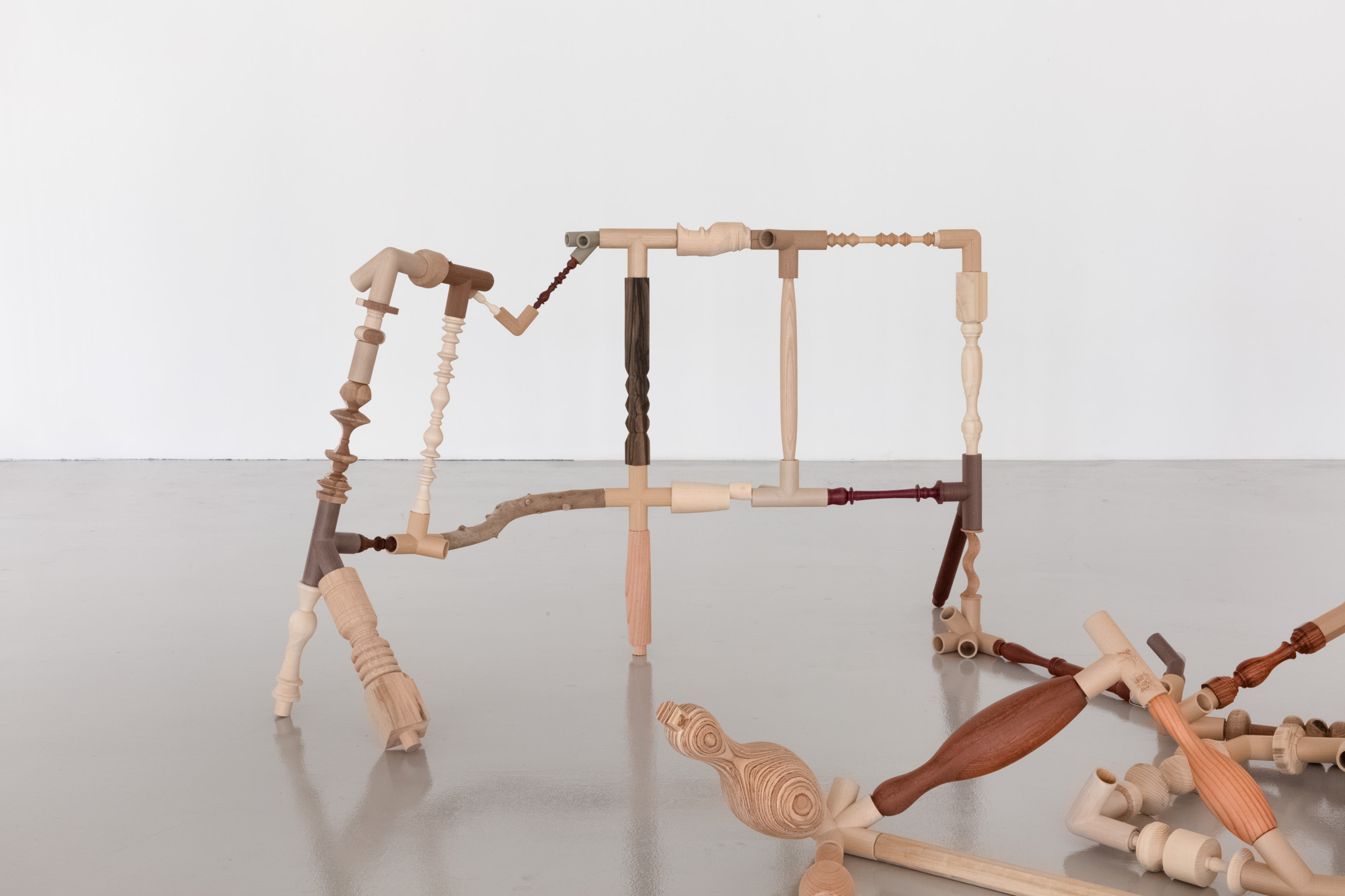
“Mutual influence cannot be negated”
Shirley Tse’s “Stakes and Holders” was launched in July at the M+ Pavilion after Hong Kong’s public facilities were shuttered for months due to Covid-19. The show closed shortly thereafter as another wave of cases erupted, and only re-opened recently. Furthermore, with Tse grounded in Los Angeles and curator Christina Li in Amsterdam, all conversations regarding the show’s installation occurred remotely.
Under such peculiar conditions, Tse’s sculptural installations—previously displayed at the 58th Venice Biennale’s Hong Kong Pavilion—examining interconnectedness and Hong Kong’s sociopolitical landscape, take on new meaning. Negotiated Differences (2019–20), comprised of unique wood pieces sculpted into both recognizable and unfamiliar shapes, arranged in an undulating structure across half of the gallery, symbolically evokes the divergent forces seemingly perforating all realms today—from politics to social matters and public health issues, dissension is de rigueur. Various emblems of friction are embedded within the installation, such as a gavel representing the democratic party’s majority gain over the republicans in the United States House of Representatives in 2018. Meanwhile, Playcourt (2019–20), mimicking a game of badminton, features an assortment of materials, including wooden rackets and aluminum bleachers. Deliberately disarrayed, the work highlights the complexity of agency when mutual influence cannot be negated, just as one’s move during a match is dependent on the actions of one’s opponent or partner.
Outside, antennas and speakers—part of Playcourt—pick up and play numerous radio channels. With the projected heterogeneous voices, one is reminded of the importance of communication and public expression, now more than ever. LAUREN LONG
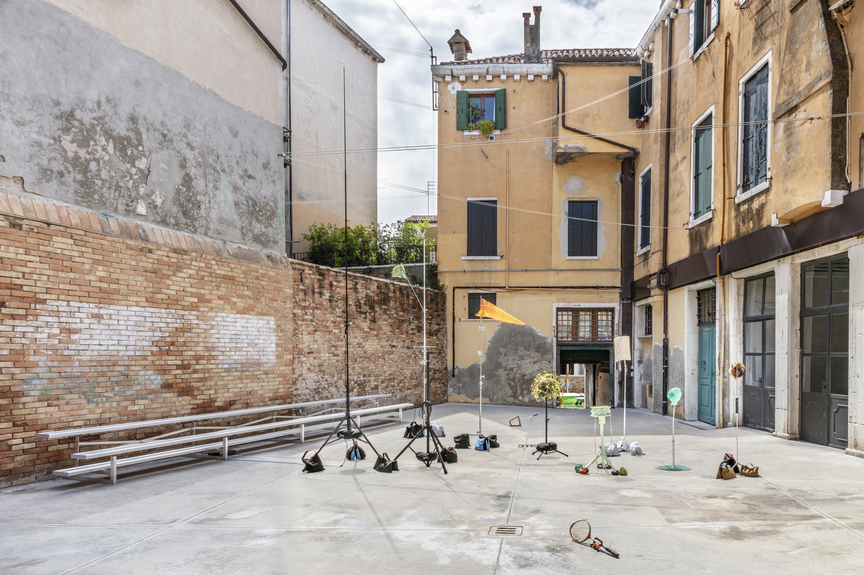
“A practice whose roots have deepened”
Pre-crisis art operates in a way that seems almost strange now. Stretched out along the ground and snaking up columns at the M+ Pavilion, Tse’s Negotiated Differences (2019–20) was like a languid tropical vine extending itself greedily for more sunshine in contrast to the knotted, anguished rhizome I remember from the Hong Kong Pavilion in Venice one year ago. The quasi-anthropomorphic forms of Playcourt (2019–20), compared to its earlier iteration, are more deconstructed and look less like figures engaged in a courtyard badminton game. It seems appropriate that they too have “relaxed” and taken up positions on the benches, as if they feel more at home in Hong Kong than on the international stage.
Tse’s installations, which employ methods the artist began developing back in 2014, were also a reminder that even the experience of looking at art in the pre-crisis era was different. The slowness and attention to detail required in viewing the installations makes for a pleasant experience, aside from the recurring interruptions of docents and guards. There are no dire warnings or sirens in Tse’s art. Nothing is spelled out in a slogan. Instead Tse’s abstracted forms speak to a practice whose roots have deepened and multiplied over time. I also recommend a walk around West Kowloon to supplement a sense of pre-crisis life’s pleasures in public places and other people—recalling what the project’s curator, Christina Li (writing about Tse’s works) describes as “the inherent difference and subjectivities of a pluralistic world of flows, movements, and connections.” HG MASTERS
Shirley Tse’s “Stakes and Holders” is on view at the M+ Pavilion, Hong Kong, until November 1, 2020.
HG Masters is ArtAsiaPacific’s deputy editor and deputy publisher; Chloe Chu is managing editor; Ophelia Lai is associate editor; Lauren Long is web and news editor; Jae Lamb is an editorial intern.







